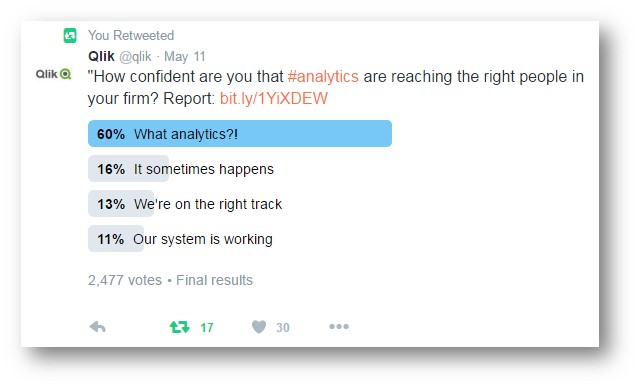The Double Entendre. Have you ever stopped to think what the word “nice” means? Per the Oxford Dictionary’s online blog entitled, “What is the strangest change in a word’s meaning?, “The word nice, derived from Latin nescius meaning ‘ignorant’, began life in the fourteenth century as a term for ‘foolish’ or ‘silly’. From there it embraced many a negative quality, including wantonness, extravagance, and ostentation, as well as cowardice and sloth.

In the Middle Ages it took on the more neutral attributes of shyness and reserve. It was society’s admiration of such qualities in the eighteenth century that brought on the more positively charged meanings of ‘nice’ that had been vying for a place for much of the word’s history, and the values of respectability and virtue began to take over. Such positive associations remain today, when the main meaning of ‘nice’ is ‘pleasant’ (if with a hint of damning with faint praise; it may yet turn full circle).”
I make the argument that Business Intelligence alone is not cutting it. There is a certain element of ignorance out there that I’m attempting to rid. Perhaps it’s a double entendre of sorts, taking on both definitions of “ignorance” and “respectability and virtue,” savvy?
Eradicating the misunderstanding of what business intelligence does and doesn’t do is one of the things that keeps me up at night. Therefore, one of my professional missions is to bring light to the power of advanced analytics that impacts the bottom line and to share the limitations of the business intelligence as it is commonly referred to as today. Also within my purview: Only the proper and most intelligent use of analytics will result in significant increases in financial health. It will also assist companies in continuing their existence.
Defining Business Intelligence
Let’s first get an understanding of what business intelligence actually is. Here’s a quote from Wikipedia that will get your mind on the problem at hand.
“Business intelligence and business analytics are sometimes used interchangeably, but there are alternate definitions. One definition contrasts the two, stating that the term business intelligence refers to collecting business data to find information primarily through asking questions, reporting, and online analytical processes. Business analytics, on the other hand, uses statistical and quantitative tools for explanatory and predictive modeling.”

In an alternate definition, Thomas Davenport, professor of information technology and management at Babson College, argues that business intelligence should be divided into querying, reporting, Online analytical processing (OLAP), an “alerts” tool, and business analytics. In this definition, business analytics is the subset of BI focusing on statistics, prediction, and optimization, rather than the reporting functionality.” (emphasis added)
Regardless of what definition you use, the statistics, prediction, and optimization are being used very little in the grand scheme of things. If you measured the percentage of business processes, across all businesses, that benefit from these capabilities, you’d assuredly find that the number would be extremely low. I boldly claim that this would be far below 1% (if you were, in fact, able to measure it).
To illustrate my point let’s take a look at a statement by Fern Halper in Predictive Analytics for Business Advantage (TDWI Research) from early 2014.
“Predictive analytics is making its way into organizations. Although predictive analytics is becoming a mainstream technology, it is still relatively new in most organizations. About half of the respondents to our survey were actively investigating the technology now, indicating increased interest in thetechnology. About 20% of these respondents have some predictive analytics activity already under way, perhaps a proof of concept (POC) or other experiment.”
Forward Looking
Granted the fact that predictive analytics is only one kind of advanced analytics, this does put advanced analytics adoption into perspective. Many companies, a much higher percentage indeed, have an assemblance of business intelligence in the form of reporting or business dashboards. The problem here is that this is only telling business people what has happened. It isn’t forward looking. Analytics can and should be used to change business behaviors which ultimately impact revenue. Or it will dramatically affect the cost of doing business. Think reducing waste, lowering the cost-of-sale, or carving out the fat of an organization.
Paul Groom of Kognitio, their COO, sums it up this way on their blog post, “Bridging the Gap Between Traditional BI and Big Data“…
“Technology has moved on greatly since business intelligence processes first emerged. It is estimated that around 90 per cent of the digital data in existence has been created in the last two years, and traditional business intelligence solutions have not been able to keep up with this exponential growth.
In fact, technologies in this area have reached a plateau, with many deployments struggling as they come up against the limits of what they are capable of. One of the biggest issues with these types of solutions is they are only capable of taking in transactional data and giving businesses a reactive overview of what has already occurred within their organisation.
But in today’s fast-moving world, this will not be enough to ensure success. Businesses that are solely relying on what has already happened to guide their decision-making will not be able to respond to new opportunities quickly enough, whereas their more agile competitors will be able to act as soon as opportunities emerge.”
Part of the impetus for me to write this particular post was from one of the tweets I saw recently… Check it out…

The Missing Link: Advanced Analytics
What’s missing from far too many companies today is advanced analytics capability, as I stated earlier in the post, that is forward looking. It’s not if analytics is reaching the right people… It’s if you have the right analytics and the right analytics strategy in place. In one of my previous posts, Autonomous Analytics Changes Everything, I talked about the importance of having an analytics roadmap created. It’s when, “Expert consultants work with your staff, covering the breadth of your business, to put together an approach that bridges data to measurable results.”
Companies like Modern Analytics use machine learning to constantly perform analytics that illuminates the sources of incremental revenue. In addition, the “Model Factory” can literally predict contribution margin for large projects. Their proven technologies have done this over and over again, for instance, with the giant of the giants in the energy sector.
Just Win Baby
Although I do hold the belief that Modern Analytics is one of the best analytics companies out there (because their technology is stupendous and their service is extraordinary), there are many more organizations out there that can help you shape the success and actions you take to grow your business.
Some of those whom I’ve been connecting with or learning about lately include Darwin Ecosystems, HG Data (Love their tagline… “Ridiculously Unfair Advantage”), and Podium Data. Whether it be using technology to unlock insights to change how you do business or to manage data in order to take advantage of its power, you must be looking forward, not backward. Thinking forward is knowing how you’re going to win. And winning in as many situations as possible is what it’s all about. Perhaps many of us have Donald Trump all wrong. Vince Lombardi, a famous American football coach (just so you know I love true football, “soccer” as it’s called in States, was previously a professional coach) once said, “Winning isn’t everything, it’s the only thing.”
The flow of data or information from typical business intelligence software packages looks like this:

Enterprise-wide, actionable data being analyzed and disseminated throughout an organization, sometimes with cloud-based software, looks more like this:
Strive for “Brilliance”
I don’t think that I’m supposing too much that you want your approach, your strategy and tactics to analytics, to be brilliant. Who wouldn’t want to be thought of as being clever, smart, or astute? This happens when you figure out or seek out best practices. Some of the best things in life happen when you have to search for them. Think of this example: The best travels I’ve had were when I researched the places I was going. To find the best experiences possible. I did this when I traveled to Brazil in 1997.

When you let ads dictate what you see and where you go it’s not as special, not as rich. Like jet-setting, having great analytics working in your business can be an experience. One that you’ll treasure, a memory or experience that no one can take away from you…

I’ve mentioned some of the companies that impress me. But make this process your own. Find out the smartest approach you can. But whatever you do, don’t stand still. Your colleagues, your employees, your customers and other stakeholders are counting on you. When you share with someone what you’re doing with respect to analytics, do you want to hear, “That’s nice” or would you rather hear something like, “That’s brilliant, actually”?
It’s time (if you haven’t yet already) to enter into the age of Digital Transformation. It will keep moving forward and you don’t want it to get moving so fast that you’re unable to hop on… It’s like a train that’s in the process of leaving the station. You must not get left behind… Because if you do, you won’t ever make it to your ultimate destination…
-30-

Article by channel:
Everything you need to know about Digital Transformation
The best articles, news and events direct to your inbox
Read more articles tagged: Featured






